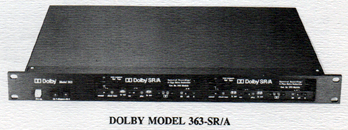 "Dolby SR provides the performance attributed to digital systems...," so the magazine ad read. Was this a marketing technique akin to Isuzu's "outrageous claims" ads of previous years, or had the mad scientists at Dolby Labs actually found a way to eliminate tape hiss, that annoying little pest of a noise that we in the analog domain have come to accept as easily as carbon monoxide in the muggy urban air? Well, we couldn't resist this Test Drive, so we made the call and got the loaner. The harmless looking model 363-SR/A arrived a couple of weeks later, neatly nestled in packing material suitable for shipping highly unstable explosives. The thin, 1-rack space 363-SR/A was accompanied by two No. 300 encode/decode modules and a half-inch think manual.
"Dolby SR provides the performance attributed to digital systems...," so the magazine ad read. Was this a marketing technique akin to Isuzu's "outrageous claims" ads of previous years, or had the mad scientists at Dolby Labs actually found a way to eliminate tape hiss, that annoying little pest of a noise that we in the analog domain have come to accept as easily as carbon monoxide in the muggy urban air? Well, we couldn't resist this Test Drive, so we made the call and got the loaner. The harmless looking model 363-SR/A arrived a couple of weeks later, neatly nestled in packing material suitable for shipping highly unstable explosives. The thin, 1-rack space 363-SR/A was accompanied by two No. 300 encode/decode modules and a half-inch think manual.
The manual furnished several pages of easy-to-understand instructions for hookup and setup procedures. Also included in the manual were several pages of very interesting information on the process of Spectral Recording or SR. The technology behind this process of noise reduction is both innovative and interesting. Sharing this technology with you was considered, but since this Test Drive is for the people in the production room and not those in the Engineering Department, we decided not to spend a page talking about the advanced technology used in the SR process (not to say that a page would even scrape the surface). The hows and whys of Dolby SR are meaningless in comparison to what our ears hear. So, this review will involve cranking up the monitors and listening for the tape hiss or lack thereof and a practical description of what we heard and how SR can be used in production and on-air application.
Installation and setup of the Dolby 363 was much easier than expected. The back panel of the unit is so well labeled that the manual wasn't even necessary to determine what went where. Instead of XLR connectors labeled, "Encoded Input" or "Decoded Output," the labeling offered simpler "From Recorder" and "To Console" descriptions for the connections. Once connections were made, the alignment procedure began. (The manual was referenced for this.) Alignment involves a few simple steps which take maybe five or ten minutes to complete. First, a 1kHz tone is sent from the console to set record levels on both the recorder and the Dolby unit. Using a small screwdriver, levels on the unit are adjusted by setting brightness levels of LED's on the front panel. Playback levels on the unit are then set in a similar fashion. For the purpose of confirming correct alignment, a final step involves recording a segment of "Dolby Noise" onto tape. This pink noise is generated by the unit and is accessed by pressing the Set-up button. During the recording process, the unit goes into the AUTO COMPARE mode. In this mode, the unit switches output repeatedly from the output of tape machine to output of the noise generator. If frequency response and levels between the two match audibly, the alignment procedure can be considered properly done. Once this is done, the system is set for recording and no further adjustment is necessary unless the unit is later installed on another recorder. The AUTO COMPARE mode also functions as a quick check of playback alignment. Anytime pre-recorded Dolby noise is input to the unit and the Set-up button is pressed, the AUTO COMPARE function is engaged and can be used to set playback levels. In a practical application of this, Dolby noise would be recorded onto the leader of a tape in much the same way that tones are used prior to spots on a reel from an agency.

